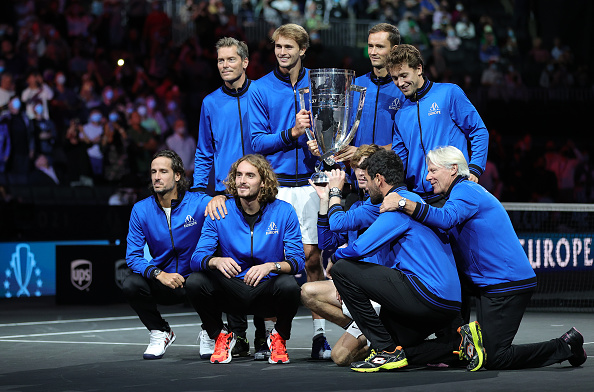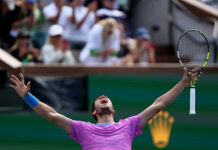Bill Simons
In the pivotal scene of the classic movie, “The Wizard of Oz,” Dorothy’s little dog Toto tugs a green curtain to the side. Suddenly the wizard is exposed. In a flash, Dorothy, the Cowardly Lion, the Tin Man and the Scarecrow realize that the Wizard is a fraud. This weekend, Toto wasn’t in Boston. But the painful truth is that the three-day Laver Cup was a bit of an exposure.
For American fans it was both a soul-deadening confirmation and an exclamation point. After all, for decades, backers of American men’s tennis have, for their mental health, called on a certain level of denial. We got spoiled by generations of elite stars who were either prominent or outright dominant. Vastly entertaining eras flowed seamlessly from one to the next. Stan Smith and Arthur Ashe seemed to pass their mojo off to Jimmy Connors, John McEnroe and Vitas Geurulaitis, who in turn handed over their wands to Pete Sampras, Andre Agassi, Jim Courier, Michael Chang and Todd Martin. Then when Andy Roddick won the 2003 U.S. Open, we blissfully assumed that American tennis would party on. But it hasn’t.
Yes, it’s comforting to know that America now has 13 male players in the top 100 and that four Americans reached the fourth round of the US Open. But, in a pyramid sport that is largely about who reaches the very top, it’s discomforting to recall that briefly this summer we didn’t have a single player in the top 30. It’s obvious that Europe – with all its stars, from Switzerland, Spain, Serbia, Italy, Greece, and now big Russia and small Norway – has a far stronger stable of established and emerging players. Americans may yet break through. There is significant reason for hope, everyone is working mightily – but the truth stings.
****
This weekend the tennis world came to Boston, where 121 years ago, Dwight Davis, a student from nearby Harvard, came up with the idea of international men’s tennis team competition. Unfortunately, in recent times, the Davis Cup had become somewhat stuck in the mud. Hampered by a long tradition, unaware of certain assets and burdened by a leaden bureaucracy, it simply couldn’t reform itself. Then it suffered a money driven over correction that weakened some of its key strengths.
Enter Roger Federer and his manager Tony Godsick, who in 2017 broke through with a daring, dazzling idea: the Laver Cup offered an eye-popping array of innovations.
Soon we were seeing superstars – supposedly arch enemies – cheering for and coaching each other. There were bright lights and beloved legends. For three heady days, the grim, bare-knuckled individualism of circuit combat was set aside. The team format was a welcome tonic for the ATP’s weary warriors. Almost magically, the Laver Cup lifted the spirits of both scarred veterans and young stars, who shone in the glow of the Laver Cup – think Alexander Zverev and this year’s MVP Andrey Rublev.
Critics, eager to rain on the wildly successful parade, howled that the Laver Cup, that has no ranking points, no prize money and plenty of guarantees, was just a dressed-up exhibition. But fans and players alike embraced and loved it. They bought in and cared. Nick Kyrgios wept when he suffered a decisive loss. All the while, the event intended to honor one of the most humble legends in sports history sparkled with Hollywood-style glitz, black-tie dinners, deep-pocket sponsors and a red-carpet mindset.
One city after another – Prague, Chicago, Geneva, Boston – has relished hosting the giddy happening with its bevy of stars. What was not to like? Plus, the Laver Cup delivered what everyone wanted: breathless cliffhangers with dramatic finishes.
But this year, doggone it, Toto got into the act. It didn’t make any difference that Team World was backed by Boston fans who know how to shriek. And the absence of the Big 3 – Roger, Rafa and Nole, plus other Euro notables, Herbert Hurkacz, Jannik Sinner, Pablo Carreno Busta and Gael Monfils – didn’t matter, either.
Norwegian Casper Ruud, 22, promptly gave Team World a rude awakening as he took down the appealing giant Reilly Opelka. The rout was on. When John Isner and Denis Shapovalov rallied to win their Friday night doubles match, German Zverev wasn’t impressed. He quipped that Team World wouldn’t win another match.
They didn’t. Yes, there were many close tiebreaks, but Team Europe won five straight matches in a row to sweep to a lopsided 14-1 victory. The lopsided competitive imbalance was clear. What wasn’t clear is whether in the near future this core issue will become a significant problem for the otherwise brilliantly conceived Laver Cup.
![]()

After all, for decades, players from distant shores have come to America to put us in our place. In 1999, Australia scored an in-your-face win in Boston on the 100th Anniversary of the Davis Cup. In 2005 in California, little Croatia scored a shocking sweep over a star-studded Davis Cup team led by Agassi, Roddick and the Bryan brothers.
Still, today was devastating. While feel-good commentators claimed, “Tennis is a game of inches,” and, “It all came down to a few points,” unsparing cynics noted that Federer had come to town on crutches and now Team World might need one or two as they left town.
In the end, Team World, in their red unies, were left humbled and red-faced after having lost eight of the nine matches. Captain John McEnroe suggested (falsely) that his head may be “on the chopping block.” Channeling his late pal Vitas Gerulaitis, he vowed, “Nobody beats John McEnroe five times in Laver Cup.”
Most tellingly, when Team Euro’s ever-diplomatic Captain Bjorn Borg suggested the proceedings “could’ve gone either way,” Boston’s unvarnished fans laughed heartily.
The truth is obvious. Nick Kyrios noted that the Euros are simply “more versatile and athletic.” Alexander Zverev said the key to Europe’s longstanding dominance was that they had better coaching. Since Roger, Rafa and then Nole emerged, it’s been essentially one-way traffic. Euros have won 66 of the last 67 Slams. Five of the top seven players in the world were in the Euro lineup, and 19 of the top 25 players are European. The top American, Reilly Opelka, is No. 19. We’ve won the Davis Cup once in the last 26 years. It has been eons since an American man has reached a Slam final. As US fans wistfully ask, “Where have you gone, Pete Sampras?” they have wisely moved the goalposts. Now we celebrate when an American fellow reaches the second week of a Slam.
Yes, America’s Frances Tiafoe is vastly entertaining and more mature. Opelka, Seb Korda, Taylor Fritz, Jenson Brooksby, Brandon Nakashima and other young Americans gave us assorted reasons for hope this season. Still, Inside Tennis asked sage John McEnroe and elder John Isner, What’s up with all this Euro domination and what can be done? They noted that long ago we got spoiled by having so many great American champions; that these matters go in cycles; that, in America, boys (as opposed to girls) are attracted to an array of other sports; and, finally, that tennis still needs to shed some of its elitist image and get more into the schools and attract great young athletes.
All the while, this weekend felt like a tornado had hit. Some called it a punch in the gut, or said it was a wake-up call, while others wondered whether American men’s tennis might possibly benefit from just a little dose of magic from the Wizard of Oz.




















American tennis overall has become soft as our culture has. Kids are worried more about their social media accounts and their phone than their workouts. Tennis is truly a worldwide sport now compared to 20 years ago. Tennis is seen as a way to a better life and college for many juniors outside the USA and they WORK for it. I have to tell my foreign juniors to get off the court and take a break. Never have that problem with American juniors.
We were pushed as juniors by coaches like Harry Hopman, Robert Lansdorp, and Nick Bollettieri. If we coach like we were coached today, we would be in jail. That is my option on America’s problem in tennis and the making of champions.
D. Tarpley
GPTCA Level-A
Agree with the above AND I’d like to add…we are doing it to ourselves.
College should be a pipeline to the pros.
It isn’t.
Look at the makeup of college teams, easily half are foreign.